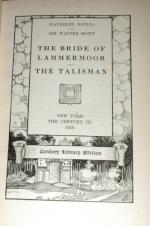CHAPTER II.
Well, lord, we have
not got that which we have;
’Tis not enough
our foes are this time fled,
Being opposites of such
repairing nature.
Henry VI. Part ii.
In the gorge of a pass or mountain glen, ascending from the fertile plains of East Lothian, there stood in former times an extensive castle, of which only the ruins are now visible. Its ancient proprietors were a race of powerful and warlike carons, who bore the same name with the castle itself, which was Ravenswood. Their line extended to a remote period of antiquity, and they had intermarried with the Douglasses, Humes, Swintons, Hays, and other families of power and distinction in the same country. Their history was frequently involved in that of Scotland itself, in whose annals their feats are recorded. The Castle of Ravenswood, occupying, and in some measure commanding, a pass betweixt Berwickshire, or the Merse, as the southeastern province of Scotland is termed, and the Lothians, was of importance both in times of foreign war and domestic discord. It was frequently beseiged with ardour, and defended with obstinacy, and, of course, its owners played a conspicuous part in story. But their house had its revolutions, like all sublunary things: it became greatly declined from its splendour about the middle of the 17th century; and towards the period of the Revolution, the last proprietor of Ravenswood Castle saw himself compelled to part with the ancient family seat, and to remove himself to a lonely and sea-beaten tower, which, situated on the bleak shores between St. Abb’s Head and the village of Eyemouth, looked out on the lonely and boisterous German Ocean. A black domain of wild pasture-land surrounded their new residence, and formed the remains of their property.
Lord Ravenswood, the heir of this ruined family, was far from bending his mind to his new condition of life. In the civil war of 1689 he had espoused the sinking side, and although he had escaped without the forfeiture of life or land, his blood had been attainted, and his title abolished. He was now called Lord Ravenswood only in courtesy.
This forfeited nobleman inherited the pride and turbulence, though not the forture, of his house, and, as he imputed the final declension of his family to a particular individual, he honoured that person with his full portion of hatred. This was the very man who had now become, by purchase, proprietor of Ravenswood, and the domains of which the heir of the house now stood dispossessed. He was descended of a family much less ancient than that of Lord Ravenswood, and which had only risen to wealth and political importance during the great civil wars. He himself had been bred to the bar, and had held high offices in the state, maintaining through life the character of a skilful fisher in the troubled waters of a state divided by factions, and governed by delegated authority; and of one who contrived to amass considerable sums of money in a country where there was but little to be gathered, and who equally knew the value of wealth and the various means of augmenting it and using it as an engine of increasing his power and influence.




